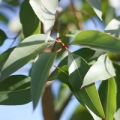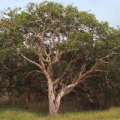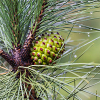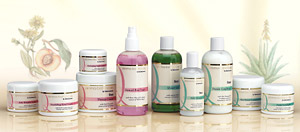Eucalyptus Globulus Essential Oil
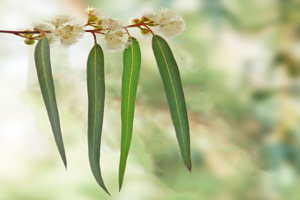 Eucalyptus essential oil is obtained from the leaves of Eucalyptus globulus, and no other species of eucalyptus has ever received as much attention from botanists and research chemists as this particular one.
Eucalyptus essential oil is obtained from the leaves of Eucalyptus globulus, and no other species of eucalyptus has ever received as much attention from botanists and research chemists as this particular one.
Due to the early discovery of its many therapeutic benefits, eucalyptus essential oil is still used today in pharmaceutical products such as cough sweets, throat lozenges and decongestants.
For many years Australia monopolised the cultivation, production and supply of eucalyptus essential oil, but since around 1940 it is no longer produced there in large quantities since essential oils from higher-yielding, or more profitable species such as E. radiata and E. smithii have become more popular.
Advances in science and technology have recently helped modernise the eucalyptus industry, with new distillation equipment and mechanical harvesting helping to reduce the cost of production. However, production of E. globulus essential oil in Australia still remains very limited, supplying to only a few small, specialist markets.
As a species, Eucalyptus globulus has been planted extensively around the world because of its rapid growth and adaptability to a wide range of environments, particularly throughout the Mediterranean. The principal essential oil producing country today is China, followed by Portugal and Spain. Other countries that produce eucalyptus globulus essential oil include Africa (Swaziland), Brazil, India, Italy, Paraguay, Russia and the USA.
Physical description
Perhaps the most attractive of all eucalyptus trees, E. globulus is a lofty, fast-growing evergreen native to south-eastern Australia and Tasmania. Among the tallest trees in the world it can reach truly gigantic heights in the wild, with some specimens reportedly exceeding 90 metres (300ft), although a height of 20 to 40 metres is more typical. Under favourable conditions this species can achieve 15 metres (50ft) in only five or six years, and enjoys a long life. A specimen in the Royal Tasmanian Botanical Gardens is claimed to be over 200 years old.
The massive straight trunk of this giant forest tree sheds its rough grey-brown bark in long strips leaving a contrasting, paler and smoother surface area in its place. The juvenile leaves are oval with square stems, and as the plant matures the leaves develop the familiar sickle-shape which hangs vertically, often growing up to 30 centimetres (12 ins) in length. The leaves are leathery and richly studded with essential oil glands, making them highly aromatic.
Traditional uses
The Aborigines used all manner of natural plant remedies including parts of the eucalyptus tree, although precisely how they were utilized would vary from tribe to tribe. The antiseptic leaves were burned to fumigate the sick and the vapours inhaled for the relief of asthma, colds and fever. Infusions were taken internally for stomach upsets, and the fresh leaves were applied directly to ease joint pain and speed up the healing of cuts, wounds and infections. Early Australian settlers named E. globulus the ‘fever tree’ because of its efficacy in treating septic and typhoid fever.
As soon as this species of eucalyptus essential oil became available in Europe it was used to treat asthma, bronchitis, croup, fevers and febrile conditions, pulmonary tuberculosis, scarlet fever, sore throats, whooping-cough, and even diphtheria and typhoid. Eucalyptus oil was added to the British Pharmacopoeia where it still remains to this day.
Harvesting and extraction
The leaves and terminal twigs of E. globulus are usually harvested by mechanical equipment and sometimes partially dried prior to extraction. Eucalyptus essential oil is obtained by steam distillation yielding a straw coloured liquid with a sharp, crisp, camphoraceous aroma with a slightly herbaceous and spicy aspect. The smell of eucalyptus is familiar to most people, and many would simply describe its aroma as ‘medicinal’.
Benefits of eucalyptus essential oil
Eucalyptus globulus essential oil is extremely versatile with powerful essential oil. A concentration of only 2% of its essential oil dispersed in a vaporizer has been shown to destroy 70% of the Staphylococcus bacteria in the affected room.
It is an excellent respiratory oil when vaporised; its astringent properties reduce mucous membrane inflammation in the upper respiratory tract, and its decongestant action loosens phlegm and unblocks sinuses. Due to the oils anti-inflammatory, stimulating and warming action, it is highly effective at easing conditions such as arthritis, rheumatic conditions and general aches and pains. It also makes an extremely effective insect repellent.
Because eucalyptus globulus essential oil is a top note it can be used to give a nice ‘lift’ to any other individual oil, and it creates a valuable pain-relieving synergy when blended with Roman or German chamomile, black pepper, clove bud, ginger, marjoram sweet, peppermint or rosemary essential oils.
This particular species of eucalyptus is generally considered to be non-irritant and non-sensitising, however do not use this essential oil on children under the age of 3 years. If a young child or baby inhales the vapour of the undiluted oil it may cause spasm of the epiglottis as a reaction to the cooling effect on the respiratory system.
And whilst we are on the subject of safety: under no circumstances should you ever take any eucalyptus essential oil internally because fatalities have been recorded after the accidental ingestion of only 5ml of this species of eucalyptus essential oil.
Browse Quinessence Eucalyptus Essential Oil
Copyright © Quinessence Aromatherapy Ltd 2021.

